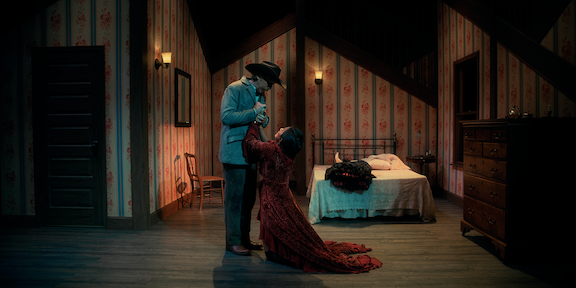The Copper Queen, a new opera film, was commissioned by Arizona Opera, and directed by CMU Drama alumna Crystal Manich, Class of 2004. Live Design chats with lighting designer Cindy Limauro about her work on this genre-bending project that has been hailed as a new genre in the world of opera, while the production comprised an all-female director/design team, the first for Arizona Opera. Watch The Copper Queen film here.
Live Design: How does one design lighting for an opera on film, as opposed to for the stage… have you done film lighting before?
Cindy Limauro: The Copper Queen opera was originally conceived and designed for the stage in a large proscenium house. When the Covid pandemic canceled the production, Arizona Opera chose to make a film rather than do a live stream without an audience. The director, Crystal Manich, and the designers kept the same concept but redesigned for film to be shot in a small black box theater.
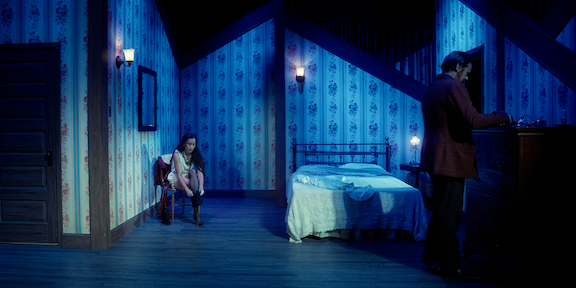
The Copper Queen takes place in the same hotel room in two time periods, alternating scenes between 1910 and 2010. There is an actual hotel called Copper Queen in Bisbee, Arizona where the story is set. The opera is a mystery and can be described as part love story and part ghost story with many twists and turns throughout.
The lighting design needed to distinguish between the time periods of 1910 and 2010, create time of day (sunrise, morning, afternoon, sunset, dusk, evening, late night), enhance moods from romantic to harsh violence to ghostly, and establish strong character relationships. Warm incandescent sources were used for 1910 while 2010 evoked cool white light based on fluorescent or white LED sources. The wall sconces and bedside lamp stayed in both time periods, but candlelight was added to 1910 and a hanging lamp and standing floor lamp were added to 2010.
Color and shadow, particularly from low angles of light, played a major role in establishing mood and telling the dramatic story. It was important to the director and I that the theatricality of a stage production be incorporated into the film version. The romantic scenes between Julia and Teddy were intimate and relied on key lighting through the window and soft candlelight or sconces. The violent scenes often used up-lighting to create harshness and intimidation through shadow while the ghost scenes were inspired by moonlight.
I have never done film lighting, but I understood lighting for camera from the many fantastic workshops taught by Bob Dickinson, Noah Mitz, and Mike Berger for my Carnegie Mellon students. This enabled me to design a light plot that would be flexible enough to accommodate whatever changes EJ Hernandez, the director of photography, needed to make it look good on film. We had a great collaboration in that EJ understood the theatrical concept and the role color and shadow played in the storytelling so whatever lighting adjustments were made for camera never changed the intention. Occasionally, EJ would augment a scene with soft film lights, mostly for close-ups on faces.
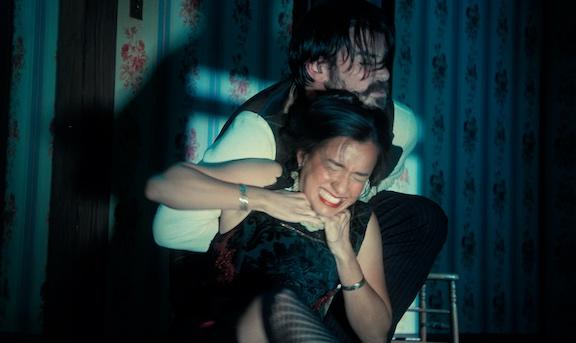
I wrote the light cues as if creating looks for the stage. This ensured the intentional theatricality of color, light, and shadow. We then had two days of camera lighting tests to make any adjustments as needed in collaboration with the director of photography. I was able to run the light cues during several rehearsals with the singers for additional tweaking. Once the crew from Manley Films arrived, we had three days of rehearsal and four days of shooting. Then it was in the capable hands of our brilliant film editor, Zack Bender.
LD: What research did you do, especially for the “dark ghostly lighting?"
CL: I did a lot of visual research for all times of day, warm and cool interior sources of room lighting to contrast the two time periods, lots of shadow imagery from different angles, and moonlight through a window not only for the night scenes but to be used for the ghostly lighting.
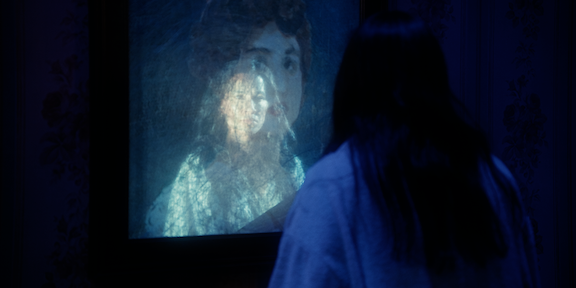
There was a separate piece of research I did that was a most interesting challenge to solve in a stage production. Spoiler alert! At the end of the opera, Addison meets Julia’s ghost through the mirror/portrait on the wall. In the 1910 scenes, Julia’s room has a mirror. In 2010, Addison stays in the hotel room which now has a portrait of Julia. In the stage production, it wouldn’t have been possible to swap out the mirror and portrait during each transition, so I elected to solve the problem by creating a frame with a front layer of see through mylar for mirror, then a second layer behind the mylar of a painted scrim portrait with a ring of LED tape around the edges to light it, and then a hard backing behind the scrim to create a solid wall. By lighting the front, it was a mirror; take out the front light and the painted portrait is revealed with the LED tape; take out the front light, take out the LED tape lighting, take off the backing and then add a light behind the scrim portrait and you will reveal a person standing there. I did a mockup test in my light lab, and it really worked! The film made for a much easier solution because we shot all the 1910 scenes and then all the 2010 scenes so we could use a real mirror in 1910 and a real portrait in 2010. However, we wanted to keep the theatrical effect of a scrim reveal so the portrait was painted on scrim with a hard backing that could be removed. It became a magical moment in the film.
LD: Where were the scenes filmed…can you talk about the lighting on the set, from placement to your choice of fixtures?
CL: The opening scenes in The Copper Queen were shot on location in Bisbee, AZ by Manley Films. EJ Hernandez, the director of photography did all the location lighting. The rest of the film was shot in Arizona Opera’s black box theater with a stage set of the hotel room and hallway designed by Liliana Duque Pineiro.
The black box theater had dedicated lighting battens which could be raised and lowered, but there was no possibility of adding any additional overhead lighting positions. So, the first thing I did was work with the scenic designer to place the set strategically in the space to get the best lighting angles possible for front, side, down, and back. Of course, the lighting angles would change orientation based on the audience’s view. 1910 would be shot from the position of looking straight on at the bed while 2010 was from the viewpoint of looking at the portrait.
I then set the trim heights at 19’-10” to be as low as possible to light eyes but be high enough to stay out of camera shots. Everyone thought I did this on purpose for the “1910” time-period, but it was purely coincidental. I worked very closely with my design assistant, John Mitchell, on figuring out very precise beam angles for lighting the acting areas and for lighting the walls.
The light plot* consisted of eight overhead battens, four rolling booms, and two moving floor mounts. The floor units were in constant use, moving to new positions in every scene. They were used as key lights through the windows, low angled specials, and up lights for shadows. The fixture choices were limited to Arizona Opera’s lighting inventory (see gear list below).
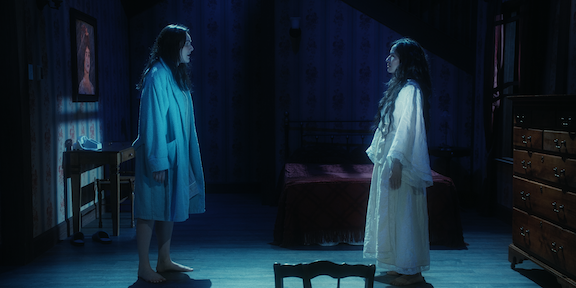
LD: What was the biggest challenge for you on this project…and the most satisfaction?
CL: The biggest challenge on this project was getting the timings and transitions between scenes perfect. We shot the scenes out of sequence and from multiple camera angles, three cameras on the floor and one overhead camera. Numerous walls were wild which made the transitions tricky in going from losing a wall to gaining a wall as we changed time periods. The director of photography and I had to be prepared for anything and quickly make lighting adjustments on the fly because the shooting schedule was so tight. It was exhilarating!
The greatest satisfaction on this project was working with a fantastic creative team of talent. I’ve designed many operas for director Crystal Manich, so we already shared a visual vocabulary and she had worked with the scenic and costume designers on previous productions. Together we created a unified vision for telling this unique story. The many months of designing and story-boarding were a labor of love and all of us are so proud of the film we produced. I learned a lot from EJ, director of photography, about filmmaking and he learned a lot from me about how I used light to convey the emotion of the story. This experience has excited me about working in this hybrid form of theater and film and I look forward to more projects like The Copper Queen.
Lighting gear list:
3 Strand Lighting SL 19
15 Strand Lighting SL 26
26 Strand Lighting SL 36
36 Apollo Scrollers
8 ETC Colorsource LED medium Pars
21 Chauvet ColoRADO 2 LED Par Zooms
4 Altman Phoenix LED 26
1 ETC Ion Console
* Click here to see the light plots for The Copper Queen in Live Design's 31 Days of Plots
